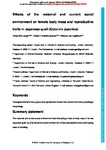Effects of the maternal and current social environment on female body mass and reproductive traits in Japanese quail (Coturnix japonica)
| dc.contributor.author | von Engelhardt, NB | |
| dc.contributor.author | Langen, E | |
| dc.contributor.author | Goerlich-Jansson, V | |
| dc.date.accessioned | 2019-01-30T20:23:22Z | |
| dc.date.issued | 2019-01-24 | |
| dc.identifier.issn | 0022-0949 | |
| dc.identifier.issn | 1477-9145 | |
| dc.identifier.other | ARTN jeb187005 | |
| dc.identifier.uri | http://hdl.handle.net/10026.1/13257 | |
| dc.description.abstract |
<jats:p>The social environment of breeding females can affect their phenotype with potential adaptive maternal effects on offspring experiencing a similar environment. We housed Japanese quail (Coturnix japonica) females in two group sizes (pair of two vs. groups of four) and studied the effects on their offspring under matched and mismatched conditions. We measured F1 body mass, reproduction, and plasma levels of androgens and corticosterone. F1 group housing led to an increase in body mass. In addition, F1 group housing had a positive effect on weight in daughters of pair-housed P0 females only, which were heaviest under mismatched conditions. At the time of egg collection for the F2 generation, F1 group females were heavier, irrespective of the P0 treatment. F1 females in groups laid heavier eggs, with higher hatching success, and produced heavier offspring, most likely a maternal effect of F1 mass. F1 plasma hormones were affected neither by the P0 nor the F1 social environment. These results contrasted with effects in the P0 (reported previously), in which plasma hormone levels differed between social environments, but not mass. This may be due to changes in adult sex ratios since P0 females were housed with males, whereas F1 females encountered males only during mating. Our study demonstrates potentially relevant mismatch effects of the social environment on F1 weights and maternal effects on F2 offspring, but further study is needed to understand their adaptive significance and physiological mechanisms.</jats:p> | |
| dc.format.extent | jeb187005- | |
| dc.format.medium | Electronic | |
| dc.language | en | |
| dc.language.iso | en | |
| dc.publisher | Company of Biologists | |
| dc.subject | Transgenerational effects | |
| dc.subject | Group size | |
| dc.subject | Reproductive investment | |
| dc.subject | Steroid hormones | |
| dc.subject | Physiology | |
| dc.subject | Morphology | |
| dc.title | Effects of the maternal and current social environment on female body mass and reproductive traits in Japanese quail (Coturnix japonica) | |
| dc.type | journal-article | |
| dc.type | Journal Article | |
| dc.type | Research Support, Non-U.S. Gov't | |
| plymouth.author-url | https://www.webofscience.com/api/gateway?GWVersion=2&SrcApp=PARTNER_APP&SrcAuth=LinksAMR&KeyUT=WOS:000461414600001&DestLinkType=FullRecord&DestApp=ALL_WOS&UsrCustomerID=11bb513d99f797142bcfeffcc58ea008 | |
| plymouth.issue | 5 | |
| plymouth.volume | 222 | |
| plymouth.publication-status | Published online | |
| plymouth.journal | Journal of Experimental Biology | |
| dc.identifier.doi | 10.1242/jeb.187005 | |
| plymouth.organisational-group | /Plymouth | |
| plymouth.organisational-group | /Plymouth/Faculty of Health | |
| plymouth.organisational-group | /Plymouth/Faculty of Health/School of Psychology | |
| plymouth.organisational-group | /Plymouth/Faculty of Science and Engineering | |
| plymouth.organisational-group | /Plymouth/REF 2021 Researchers by UoA | |
| plymouth.organisational-group | /Plymouth/REF 2021 Researchers by UoA/UoA04 Psychology, Psychiatry and Neuroscience | |
| plymouth.organisational-group | /Plymouth/Users by role | |
| plymouth.organisational-group | /Plymouth/Users by role/Academics | |
| dc.publisher.place | England | |
| dcterms.dateAccepted | 2019-01-18 | |
| dc.rights.embargodate | 2020-1-24 | |
| dc.identifier.eissn | 1477-9145 | |
| dc.rights.embargoperiod | Not known | |
| rioxxterms.funder | Volkswagen Foundation | |
| rioxxterms.identifier.project | Evolution of transgenerational effects: function & genetics of epigenetics. | |
| rioxxterms.versionofrecord | 10.1242/jeb.187005 | |
| rioxxterms.licenseref.uri | http://www.rioxx.net/licenses/all-rights-reserved | |
| rioxxterms.licenseref.startdate | 2019-01-24 | |
| rioxxterms.type | Journal Article/Review | |
| plymouth.funder | Evolution of transgenerational effects: function & genetics of epigenetics.::Volkswagen Foundation |


